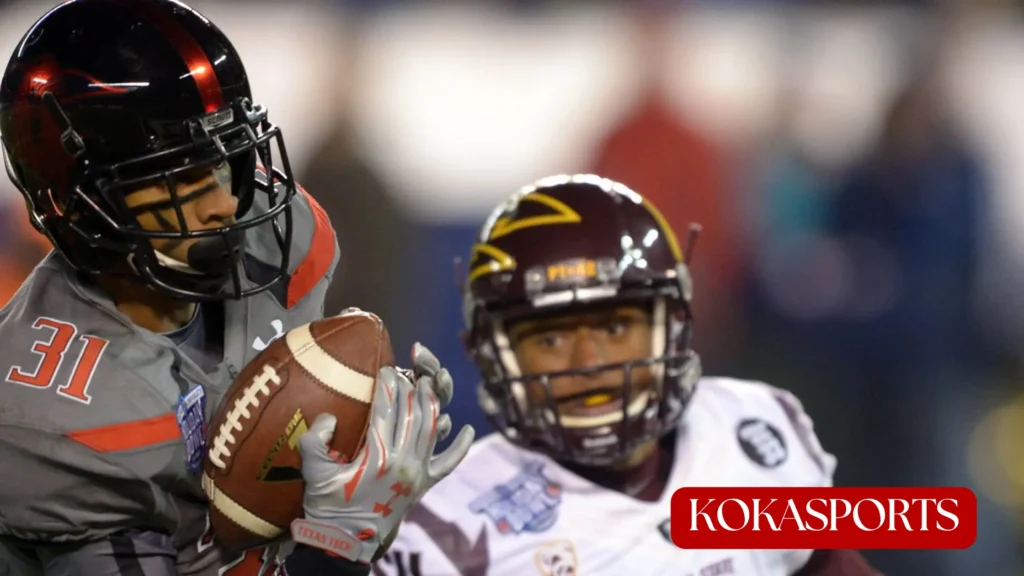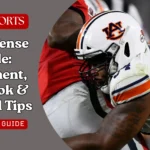What Is Cover 4 Defense?
Cover 4 Defense Explained in Simple Terms (Football 101)
Cover 4 is a zone defense that uses four deep defenders to protect against long passes. Think of it as dividing the field into four vertical sections or “quarters” – each defender watches one quarter to prevent big plays through the air.
The basic idea is simple: cover 4 uses four deep defenders positioned to stop passes behind them. These four deep defenders include two safeties and cornerbacks, all protecting their assigned zones. Unlike man coverage where defenders follow specific receivers everywhere, cover 4 assigns each player a specific area to monitor.
How Cover 4 Fits Into Modern Defensive Football Strategy
Modern offenses use spread formations and multiple receivers to challenge traditional defensive coverages. Cover 4 has become popular because it provides excellent balance – the defense can protect deep while maintaining numbers to stop the run.
Many high school and college teams use cover 4 as their base coverage because it’s simple to teach while staying effective against various offensive schemes. The coverage allows the defense to keep numbers in the box for run defense while maintaining four deep defenders to prevent big plays.

Read More: Complete Guide to the 4-4 Defense in Football
Why It’s Called “Cover 4” – The Numbering System
The numbering system in football coverage refers to how many deep defenders protect against vertical threats. Cover 4 means there are four players responsible for deep coverage. This contrasts with:
- Cover 3: Three deep defenders splitting the field into thirds
- Cover 2: Two deep defenders splitting the field in half
- Cover 1: One deep safety with everyone else in man coverage
- Cover 0: No deep help, pure man coverage with a blitz
Differences Between Cover 4 and Other Common Coverages
Cover 4 vs Cover 3: The main difference is the number of deep defenders. While cover 3 uses three deep defenders, cover 4 uses four. Cover 3 provides better support for stopping intermediate routes but can struggle against vertical concepts.
Cover 4 vs Cover 2: In cover 2, only two deep defenders split the field into deep halves. This leaves corners playing flatter, defending the flat zones. Cover 2 and cover 4 differ in how they handle the middle of the field – cover 2 leaves this area vulnerable, while cover 4 provides better protection.
Cover 4 Defense Diagram – Alignments and Responsibilities
Standard Cover 4 Alignment and Positions
Cornerbacks: Position themselves closer to the line of scrimmage than in cover 2, typically 5-7 yards off the receiver. Each cornerback takes the outside quarter of the field while balancing run support.
Safeties: Both safeties align at similar depths (10-12 yards), creating a level appearance pre-snap. The free safety and strong safety take the inside quarters and must read the formation and react to threats.
Linebackers: Typically three underneath defenders who handle short and intermediate routes. The mike linebacker reads routes through the middle while maintaining run fits. Linebackers must cover running backs releasing into routes.
Defensive Line: Generate pressure on the quarterback while maintaining gap integrity against run plays.
| Position | Alignment | Primary Responsibility | Secondary Role |
|---|---|---|---|
| Corners | 5-7 yards off WR | Outside quarter deep coverage | Force player on runs |
| Safeties | 10-12 yards depth | Inside quarter deep coverage | Run support downhill |
| Linebackers | 4-5 yards depth | Underneath coverage zones | Primary run defenders |
| D-Line | Line of scrimmage | Pass rush / run gaps | Contain quarterback |
Adjustments Based on Offensive Formations
Trips Formation: When three receivers go to one side, the safety widens, the corner maintains outside leverage, and a linebacker or nickel defender takes the slot receiver. This creates cover 4 to one side with modified rules.
Empty Formation: With no running back, linebackers cover the middle zones while the coverage becomes pure quarters with pattern match principles.
2×2 Sets: This balanced formation with two receivers on each side represents the ideal scenario for cover 4. Each side has a corner and safety to cover their quarters cleanly.
Cover 4 Defense Football Strategies – How It Works on the Field

Cover 4 as a Zone Defense – Pattern Reading and Match Principles
While cover 4 starts as zone coverage, modern versions incorporate pattern match principles. Defenders read route combinations and make smart decisions about which threats to prioritize. This man and zone hybrid approach gives tremendous flexibility.
If a corner sees a receiver running vertical while another runs short, he must match the vertical threat because that attacks his quarter. Meanwhile, an underneath defender picks up the shorter route.
Run Defense in Cover 4
Against the run game, cover 4 provides eight defenders near the line of scrimmage. The other safety reads run and reacts downhill, giving the defense a ninth player.
Safeties become force players in cover 4, setting the edge and turning run plays inside to pursuing defenders. This differs from cover 2, where corners typically handle force duties.
Pass Defense in Cover 4
In pass defense, each deep quarter defender protects everything in front of them while preventing throws over their head. The key is maintaining proper depth – staying deeper than the deepest receiver in your zone.
Deep quarter responsibilities include reading the quarterback’s eyes and drop back, communicating with adjacent defenders about route crossers, and never allowing a receiver behind you.
Strengths and Weaknesses of Cover 4 Defense
Cover 4 Defense Strengths
Deep pass protection: With four deep defenders, the coverage excels at preventing explosive plays. Coverage against deep passes remains tight because defenders stay on top of vertical routes.
Run defense support: Eight players near the box provide excellent numbers. The extra safety creates a numbers advantage that few running schemes can block effectively.
Versatility vs multiple formations: Whether facing trips, empty, or balanced sets, cover 4 adjusts without complete schematic overhauls.
Strong vs play action: Because safeties read the quarterback and don’t bite on play fakes aggressively, the coverage maintains integrity even when offenses sell run convincingly.
Cover 4 Defense Weaknesses
Vulnerability to short routes: With only three underneath defenders against five eligible receivers, short passes find windows. The flat areas and curl zone spaces become available.
Stress on linebackers: Linebackers must cover more ground than in other coverages. They need to drop back into underneath zone coverage while reading run.
Route combos that attack quarters coverage: Specific combinations systematically stress cover 4:
- Smash: Corner route with a hitch, forcing the defender to choose
- Flood: Three receivers overwhelm two defenders on one side
- Four verticals: Stretches all four deep defenders, creating seams
How Teams Try to Beat Cover 4 Defense
Offensive coordinators use several strategies to attack cover 4:
- RPO: Forces the safety to commit to run or pass, creating conflict
- Levels concepts: Three receivers at different depths stress the corner and safety
- Middle seams: Attacks space between inside quarters
- Quick game: Gets the ball out before coverage settles
Variations of Cover 4 Defense

Spot Drop Cover 4 vs Pattern-Match Cover 4
Spot drop cover 4 assigns each defender a specific zone regardless of routes. This simpler version works well for younger players to cover their areas.
Pattern match cover 4 requires defenders to recognize route combinations and adjust. If two receivers run vertical, the corner and safety match them. If one breaks short, the underneath defender picks him up.
Cover 4 “Palms” Coverage
Palms represents an aggressive cover 4 variation where corners play tighter technique. The corner reads the 2 receiver’s release – if he goes vertical, the corner runs with him. If he breaks inside or short, the corner passes him to the safety.
When Defensive Coordinators Choose Cover 4
A defensive coordinator selects cover 4 when:
- Facing multiple vertical threats
- Wanting better middle of the field protection than cover 3 provides
- Needing run support from safeties
- Playing spread teams
The decision between cover 2 and 4 or cover 1 and cover 3 depends on opponent tendencies and situations.
Cover 4 Defense in Youth, High School, College, and the NFL
Why Cover 4 Defense Is Popular in High School and College
High school and college teams favor cover 4 because it’s relatively simple, provides run support, adjusts to spread formations easily, and teaches pattern recognition. Many successful programs build their entire defense around quarters principles.
Why NFL Teams Run Less Traditional Cover 4
NFL offenses exploit traditional cover 4 with precision routes and elite quarterbacks who dissect zone coverage. Professional teams use cover 4 concepts within hybrid packages that disguise better pre-snap.
Film Study – What to Look for When Identifying Cover 4 Defense
Pre-Snap Keys for Fans and QBs
Quarterbacks look for:
- Two safeties at similar depths
- Corners playing 5-7 yards off
- Safety alignment over slot receiver areas
- Balanced look without obvious blitz indicators
Post-Snap Rotation Clues
After the snap, watch for:
- All four deep defenders drop back to depth
- Safeties not flying downhill immediately on play-action
- Corners maintaining outside leverage while retreating
How to Tell Cover 4 Apart from Cover 3 or Cover 2
Cover 4 vs Cover 3: In cover 3, the free safety aligns much deeper and corners play tighter. Cover 3 shows three deep defenders versus four.
Cover 4 vs Cover 2: Cover 2 places corners much flatter. The two deep safeties in cover 2 split the field in half, creating a distinct look from the quartered approach.
Common Mistakes When Running Cover 4 Defense
Safeties Getting Too Deep Too Early
Young safeties often retreat too fast, creating throwing windows underneath. They must balance gaining depth with reading the play. Getting too deep eliminates run support value.
Corners Overplaying Verticals
Corners sometimes panic about getting beat deep and bail too quickly. This abandons run support and creates easy windows short. Corners must trust their technique and safety help.
LBs Getting Lost in Coverage
Linebackers sometimes struggle reading where to go in coverage. They might flow with run action when they should drop back, or vice versa.
Conclusion
Cover 4 shines in specific situations:
Ideal situations:
- Against balanced offenses that run and pass effectively
- When facing vertical passing attacks
- Protecting leads where preventing big plays matters most
- Against spread teams
Suggested uses:
- Teams should play cover 4 as base when opponents use multiple receivers
- Against trips-heavy offenses
- In the red zone where the compressed field favors four deep defenders
Cover 4 as part of a complete system: No single coverage solves every problem. Cover 4 works best as part of a package including cover 3, cover 2, cover 1, and cover 6 variations. Teams with strong safety play and smart linebackers will find cover 4 is a great foundation for a complete defense that can defend modern offensive football at any level.
FAQs
What is a Cover 4 defense?
Cover 4 is a zone defense in football where four defensive backs each cover one deep quarter of the field to protect against long passes.
What are the weaknesses of Cover 4?
Cover 4 can be vulnerable to short passes, quick underneath routes, and route combinations that stress linebackers and safeties.
Is Cover 4 defense better than Cover 2?
Cover 4 is better against deep passes and modern spread offenses, while Cover 2 is stronger against short and intermediate passes. The “better” choice depends on opponent and game situation.
What is Cover 5 defense?
Cover 5 is a coverage where defenders play two deep safeties and man coverage underneath, often called “2-Man,” combining man coverage with deep help over the top.



